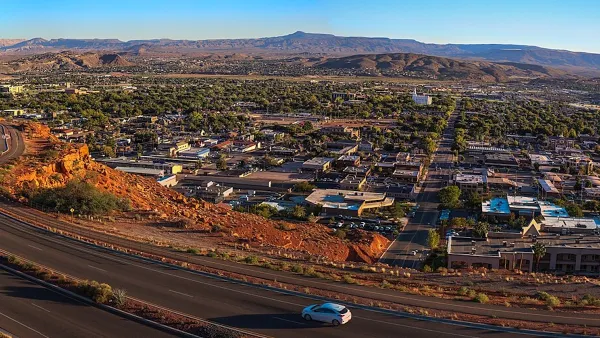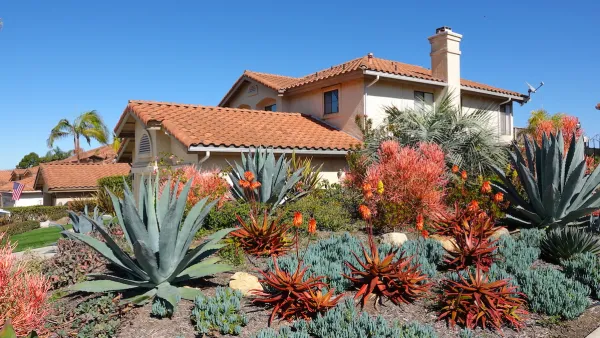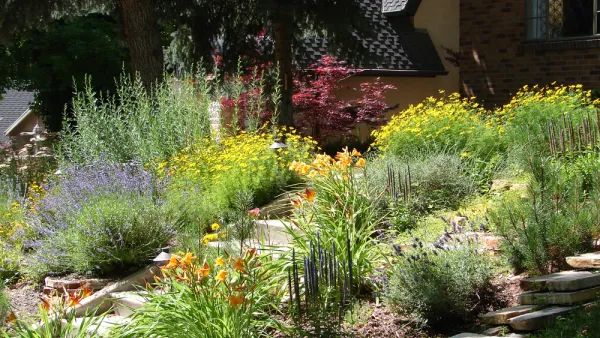The New Yorker traces the history of the American lawn from 1841, commenting on their unnatural origins, and finally analyzing the alternatives suggested by anti-lawn movements.
If one accepts the idea that lawns are, in a deep sense, unethical, how does one fill the front yard?
Over the years, many alternatives to the lawn have been proposed. Pollan, in his book "Second Nature" (1991), suggests replacing parts-or all-of the lawn with garden. In "Noah's Garden" (1993), Sara Stein, by contrast, advocates "ungardening"-essentially allowing the grass to revert to thicket. Sally and Andy Wasowski, in their "Requiem for a Lawnmower" (2004), recommend filling the yard with native trees and wildflowers. For those who don't want to give up the look or the playing space provided by a lawn, the Wasowskis suggest using Buffalo grass, one of the very few turf species native to North America. Smaller American Lawns Today, or SALT, is a concept developed by William Niering, who for many years was a professor of botany at Connecticut College. Niering planted trees around his property, then left most of the rest of his yard unmowed, to become a meadow. "The meadow can take as much of your remaining lawn as you want," he observes in an essay posted on SALT's Web site. "There are some people who prefer no lawn, which is ideal!" For the past few decades, David Benner, a horticulturist from Bucks County, Pennsylvania, has been touting moss as an alternative to grass: he himself has a one-acre "moss garden." Recently, there have been several calls to make the lawnspace productive. In "Food Not Lawns" (2006), Heather C. Flores argues that the average yard could yield several hundred pounds of fruits and vegetables per year. (If you live in an urban area and don't have a lawn, she suggests digging up your driveway.) "Edible Estates" (2008) is the chronicle of a project by Fritz Haeg, an architect and artist, who rips up conventional front yards in order to replace them with visually striking "edible plantings." Haeg calls his approach "full-frontal gardening."
FULL STORY: Turf War

Analysis: Cybertruck Fatality Rate Far Exceeds That of Ford Pinto
The Tesla Cybertruck was recalled seven times last year.

National Parks Layoffs Will Cause Communities to Lose Billions
Thousands of essential park workers were laid off this week, just before the busy spring break season.

Retro-silient?: America’s First “Eco-burb,” The Woodlands Turns 50
A master-planned community north of Houston offers lessons on green infrastructure and resilient design, but falls short of its founder’s lofty affordability and walkability goals.

Test News Post 1
This is a summary

Analysis: Cybertruck Fatality Rate Far Exceeds That of Ford Pinto
The Tesla Cybertruck was recalled seven times last year.

Test News Headline 46
Test for the image on the front page.
Urban Design for Planners 1: Software Tools
This six-course series explores essential urban design concepts using open source software and equips planners with the tools they need to participate fully in the urban design process.
Planning for Universal Design
Learn the tools for implementing Universal Design in planning regulations.
EMC Planning Group, Inc.
Planetizen
Planetizen
Mpact (formerly Rail~Volution)
Great Falls Development Authority, Inc.
HUDs Office of Policy Development and Research
NYU Wagner Graduate School of Public Service




























